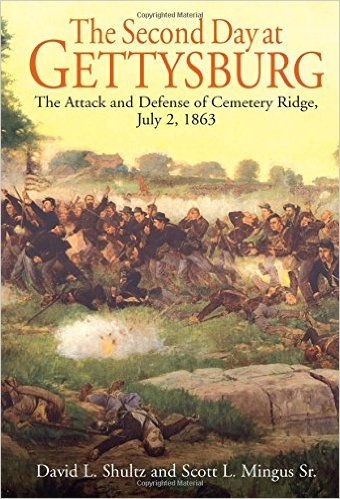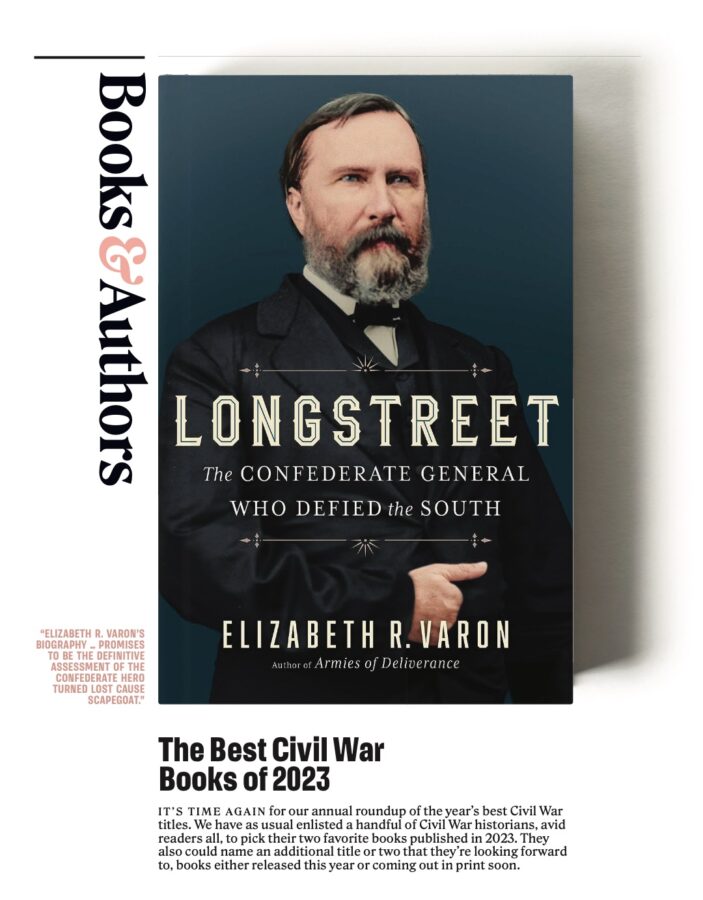The Second Day at Gettysburg: The Attack and Defense of Cemetery Ridge, July 2, 1863 by David L. Shultz and Scott L. Mingus, Sr. Savas Beatie, 2015. Cloth, ISBN: 978-1611210743. $32.95.
 In 1987, Harry Pfanz published his groundbreaking study, Gettysburg: The Second. Six years later, Gary W. Gallagher edited a series of essays on Confederate and Union leadership at Gettysburg on July 2. In 1999, John D. Imhof gave us his remarkable Gettysburg Day Two: A Study in Maps, followed in 2000 by R.L. Murray’s booklet, E.P. Alexander and the Artillery Action in the Peach Orchard. Two other specialty works, Jay Jorgensen’s Gettysburg’s Bloody Wheatfield and Don Ernsberger’s At the Wall: The 69th Pennsylvania ‘Irish Volunteers’ at Gettysburg, appeared in 2002 and 2006, respectively.
In 1987, Harry Pfanz published his groundbreaking study, Gettysburg: The Second. Six years later, Gary W. Gallagher edited a series of essays on Confederate and Union leadership at Gettysburg on July 2. In 1999, John D. Imhof gave us his remarkable Gettysburg Day Two: A Study in Maps, followed in 2000 by R.L. Murray’s booklet, E.P. Alexander and the Artillery Action in the Peach Orchard. Two other specialty works, Jay Jorgensen’s Gettysburg’s Bloody Wheatfield and Don Ernsberger’s At the Wall: The 69th Pennsylvania ‘Irish Volunteers’ at Gettysburg, appeared in 2002 and 2006, respectively.
Notwithstanding extensive scholarship focusing on the second day at Gettysburg, David L. Shultz and Scott L. Mingus, Sr., understood the need for an in-depth study dissecting the complicated attack and defense of Cemetery Ridge—particularly the actions occurring between the Trostle and Hummelbaugh farm lanes. Since this examination could not be conducted in isolation, the authors included July 1 confrontations and earlier activity on July 2 as a prelude to their primary focus on Cemetery Ridge.
Despite Maj. Gen. J.E.B. Stuart’s delay in arriving at Gettysburg with three of his cavalry brigades, Gen. Robert E. Lee did not employ available cavalry to reconnoiter enemy positions at Gettysburg. Instead, he sent a member of his staff, Captain Samuel Johnston, on an early morning July 2 reconnaissance of the Union left flank with controversial results. This set the stage for delays and some foot-dragging in getting Lt. Gen. James Longstreet’s forces in position to attack the enemy from that direction. Maj. Gen. Daniel Sickles’ unauthorized movement of his Union Third Corps to the Emmitsburg Road heralded confusion and complications for both sides once the Confederate attack finally got underway mid-afternoon. This corps anchored the Union left flank.
A key to the outcome of the day’s fighting was ability of Union forces to maintain control of the Hummelbaugh farm lane that connected the Emmitsburg and Taneytown roads. This lane was seen as critical to Union Second Corps commander Maj. Gen. Winfield Scott Hancock’s entire position in the center. Fortunately for the Union forces, they gained the upper hand in a long- range artillery confrontation with Lt. Gen. A.P. Hill’s corps on this part of the field because of superior ordnance and material, and better-trained personnel.
Lee benefited when Union commander Maj. Gen. George G. Meade ignored evidence that his army was superior in strength, which led him to operate defensively and limited his combat assertiveness. Cavalry commander Maj. Gen. Alfred Pleasonton’s decision to allow Brig. Gen. John Buford’s division to leave the field for refitting prior to the arrival of other Union cavalry on the battlefield exacerbated the situation, leaving the left flank without a cavalry screen.
A countermarch to avoid observation by the Union signal station on Little Round Top delayed Longstreet’s forces in reaching the designated attack position on the Union left flank. Once the assault was finally underway about 4 p.m., time became an important issue in the evolving confrontation.
The complexity of simultaneous actions becomes apparent as the authors piece together the details of each encounter. The maps included are essential to following and understanding the unfolding drama. A key element is the depiction of the combined artillery and infantry combat escalating across the battlefield. Detailed explanations reflect the authors’ expertise on artillery.
The crux of this study is the fight for the Union center. Hancock’s heroics in plugging gaps in the Union line against the pounding it took (particularly from Brig. Gen. Cadmus M. Wilcox’s and Brig. Gen. Ambrose R. Wright’s brigades) late in the day were paramount to repulsing the attack. This day, Hancock truly earned his sobriquet “the superb.”
The authors do not address July 2 intelligence-related aspects that are documented in the historical record. Analysis of the contributions of the Army of the Potomac intelligence specialists who interrogated rebel prisoners captured during the battle—and who produced timely reports for Meade—would add another dimension to the usual emphasis on infantry, artillery and cavalry.
Nonetheless, Shultz and Mingus have set a new standard for the July 2 action at Gettysburg, especially with regard to the critical engagements that took place toward the center of the line on Cemetery Ridge. Every Gettysburg aficionado will want to add this book to their collection, and Civil War readers in general will appreciate the high level of research and discourse.
Thomas J. Ryan is the author of Spies, Scouts, and Secrets in the Gettysburg Campaign: How the Critical Role of Intelligence Impacted the Outcome of Lee’s Invasion of the North, June-July 1863.
